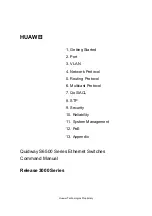
23
Rev NR
cable RxC in the Pin Source Register. Since the FPGA will source both USC clocks, they must be programmed as
inputs in the USC I/O Control Register.
The preceding suggestions should work for most applications. The default Pin Source Register value should set the
clocks to work with both scenarios – USC TxC pin = Programmable Clock, USC RxC Pin = Cable RxC, Cable TxC
= Programmable Clock. (For async, use USC TxC is input clock).
3.6
Multiprotocol Transceiver Control
The SIO8BX2 has multiprotocol transceivers which allow RS422/RS485 and RS232 modes. The mode is set by the
Protocol Mode field in the Pin Source Register.
Mode
TxC
RxC
AuxC
TxD
RxD
RTS
CTS
DCD
RS-422/RS-485
RS-422
RS-422
RS-422
RS-422
RS-422
RS-422
RS-422
RS-422
RS-232
RS-232
RS-232
RS-232
RS-232
RS-232
RS-232
RS-232
RS-232
3.7
DCE/DTE Mode
As all signals are bidirectional, the DCE or DTE mode will set the direction for each signal. For the transceivers to
be configured as either DTE or DCE, set the DCE/DTE Enable bit in the Pin Source register (D31). The following
table gives the input/output configuration for each signal: The DCD and AuxC direction is set in the Pin Source
register fields, independent of DCE/DTE mode.
Signal
DTE
DCE
TxC
TxC Out
RxC In
RxC
RxC In
TxC Out
TxD
TxD Out
RxD In
RxD
RxD In
TxD Out
RTS
RTS Out
CTS In
CTS
CTS In
RTS Out
DCD
Direction controlled by Pin Source Reg D16:15
AuxC
Direction controlled by Pin Source Reg D18:17
3.8
Loopback Modes
For normal operation, the Cable Transceiver Enable bit of the Pin Source Register will turn on the cable transceivers,
and the DTE/DCE Mode bit will set the transceiver direction. These bits must be set before any data is transmitted
over the user interface.
Additionally, there are several ways to loopback data to aid in debug operations. Data may be physically looped
back externally by connecting one channel to another. For DB25 cable applications, this simple loopback method
will requires a gender changer to connect one channel to another. One channel will be set to DTE mode, the other to
DCE mode. Data sent from one channel will be received on the other.
An External Loopback mode (External Loopback bit set in the Pin Source Register) is also provided to loop back
data on the same channel without requiring any external cabling. In this mode, the DTE/DCE mode will control the














































